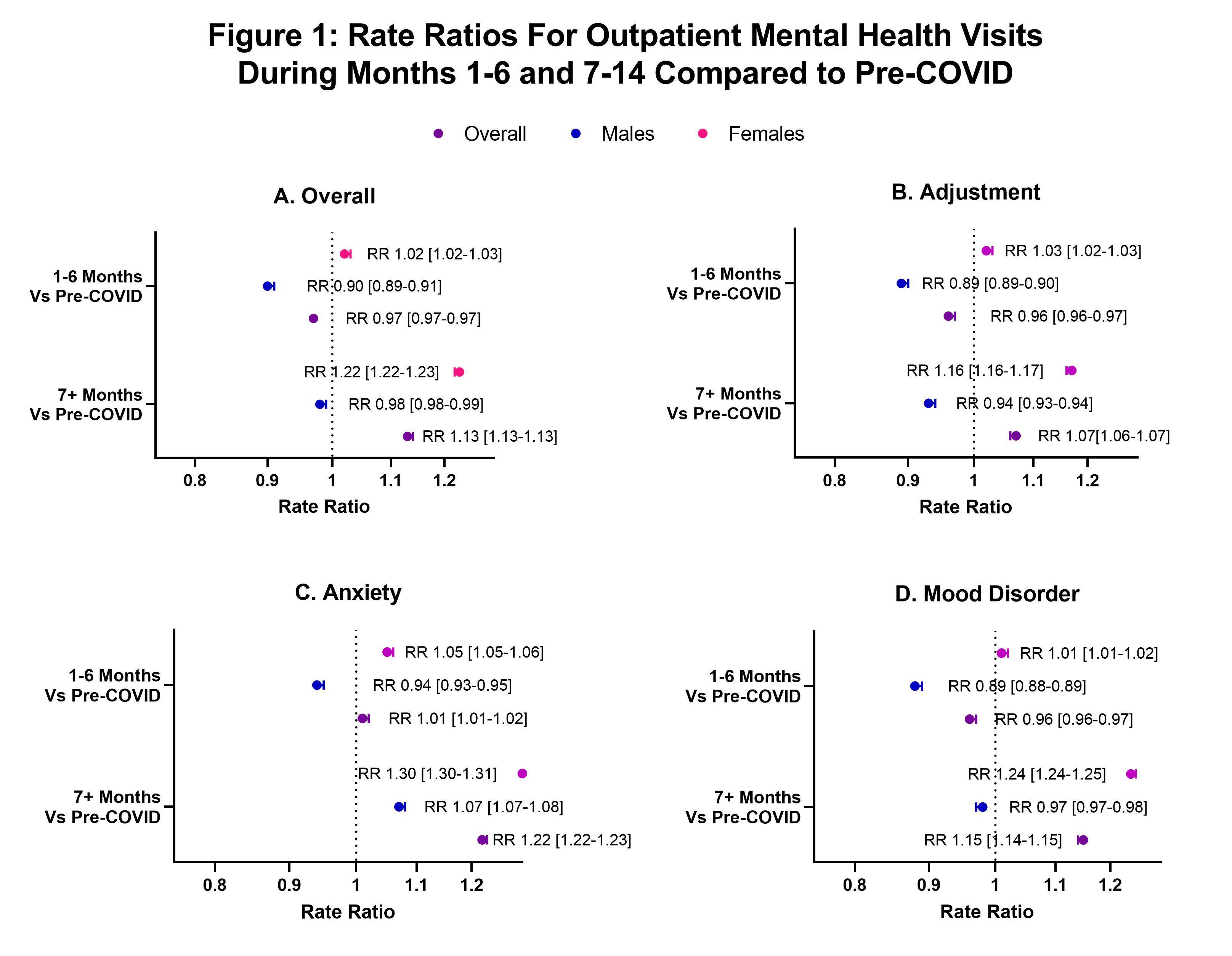Mental Health
Category: Abstract Submission
Mental Health I
517 - Child and Youth Outpatient Mental Healthcare Use During COVID-19
Monday, April 25, 2022
3:30 PM - 6:00 PM US MT
Poster Number: 517
Publication Number: 517.422
Publication Number: 517.422
Maxwell Ebert, Uniformed Services University of the Health Sciences F. Edward Hebert School of Medicine, Bethesda, MD, United States; Apryl Susi, Uniformed Services University of the Health Sciences F. Edward Hebert School of Medicine, Bethesda, MD, United States; Cade M. Nylund, Uniformed Services University of the Health Sciences F. Edward Hebert School of Medicine, Bethesda, MD, United States; Ian S. Sorensen, Uniformed Services University of the Health Sciences F. Edward Hebert School of Medicine, Bethesda, MD, United States; Madeline Dorr, Uniformed Services University of the Health Sciences F. Edward Hebert School of Medicine, McLean, VA, United States; Jayasree Krishnamurthy, Uniformed Services University of the Health Sciences F. Edward Hebert School of Medicine, Bethesda, MD, United States; Elizabeth Hisle-Gorman, Uniformed Services University, Bethesda, MD, United States

Maxwell Ebert, MPH
Pediatric Research Associate
Uniformed Services University of the Health Sciences F. Edward Hebert School of Medicine
Bethesda, Maryland, United States
Presenting Author(s)
Background: Survey research indicates that the mental health of children and adolescents has deteriorated during the COVID-19 pandemic. However, the full effect of the COVID-19 pandemic on mental health diagnoses and care remains unknown.
Objective: Examine the impact of the COVID-19 pandemic on outpatient mental healthcare use for mood, anxiety, and adjustment disorders.
Design/Methods: This retrospective cohort study used military health system (MHS) data to examine outpatient mental healthcare use of military connected children and youth ages 3-21. ICD-10 codes identified outpatient encounters with diagnosed mood, anxiety and adjustment disorders; outcomes were analyzed by specific diagnosis and overall, and stratified by sex. Time periods were categorized as pre-COVID-19 (Jan 2019-March 2020), COVID Months 1-6 (April 2020-Sept 2020), and COVID Months 7-14 (Oct 2020 to March 2021). Kruskal-Wallis was used to compare the mean rate of individuals receiving care by time period. Poisson regression analysis determined care rates, both monthly and by time period, for trends in mental healthcare use.
Results: On average, 2,405,000 unique individuals aged 3-21 were included monthly. The mean rate of individuals receiving mental health care pre-COVID-19 was 343/10,000, 296/10,000 during months 0-6 and 341/10,000 in months 7-14 (p=0.005). During months 1-6, the rate of outpatient mental health visits decreased 3%, compared to pre-COVID-19; in months 7-14, visits increased 13% compared to pre-COVID (Fig. 1). Compared to pre-COVID, care decreased in months 1-6 for adjustment and mood disorder (4%, 4%), and anxiety care increased 1%. Rates of care for all conditions were increased in females for all time periods compared to pre-COVID-19 (Figure 1). As compared to pre-COVID-19, care increased in months 7-14 for adjustment, mood, and anxiety disorders (7%, 15%, 22%). Over the full study period care was increased for mental health overall (0.6%) per month and for anxiety, adjustment, and mood disorders (0.1%, 0.3%, 0.7%). (Fig 2). Conclusion(s): The initial drop in mental healthcare utilization during COVID-19 coincides with social distancing precautions/telehealth solutions that were not scaled up. The increased rate of mental healthcare use in months 7-14, overall and among females in particular, suggests that COVID-19 era stressors dramatically increased the need for mental healthcare services, with particular attention to females. It is unclear if significant trends of increased care over the full study period are following pre-existing trends or related to COVID-19 upticks in care.
Figure 1: Rate Ratios For Outpatient Mental Health Visits During Months 1-6 and 7-14 Compared to Pre-COVID
Objective: Examine the impact of the COVID-19 pandemic on outpatient mental healthcare use for mood, anxiety, and adjustment disorders.
Design/Methods: This retrospective cohort study used military health system (MHS) data to examine outpatient mental healthcare use of military connected children and youth ages 3-21. ICD-10 codes identified outpatient encounters with diagnosed mood, anxiety and adjustment disorders; outcomes were analyzed by specific diagnosis and overall, and stratified by sex. Time periods were categorized as pre-COVID-19 (Jan 2019-March 2020), COVID Months 1-6 (April 2020-Sept 2020), and COVID Months 7-14 (Oct 2020 to March 2021). Kruskal-Wallis was used to compare the mean rate of individuals receiving care by time period. Poisson regression analysis determined care rates, both monthly and by time period, for trends in mental healthcare use.
Results: On average, 2,405,000 unique individuals aged 3-21 were included monthly. The mean rate of individuals receiving mental health care pre-COVID-19 was 343/10,000, 296/10,000 during months 0-6 and 341/10,000 in months 7-14 (p=0.005). During months 1-6, the rate of outpatient mental health visits decreased 3%, compared to pre-COVID-19; in months 7-14, visits increased 13% compared to pre-COVID (Fig. 1). Compared to pre-COVID, care decreased in months 1-6 for adjustment and mood disorder (4%, 4%), and anxiety care increased 1%. Rates of care for all conditions were increased in females for all time periods compared to pre-COVID-19 (Figure 1). As compared to pre-COVID-19, care increased in months 7-14 for adjustment, mood, and anxiety disorders (7%, 15%, 22%). Over the full study period care was increased for mental health overall (0.6%) per month and for anxiety, adjustment, and mood disorders (0.1%, 0.3%, 0.7%). (Fig 2). Conclusion(s): The initial drop in mental healthcare utilization during COVID-19 coincides with social distancing precautions/telehealth solutions that were not scaled up. The increased rate of mental healthcare use in months 7-14, overall and among females in particular, suggests that COVID-19 era stressors dramatically increased the need for mental healthcare services, with particular attention to females. It is unclear if significant trends of increased care over the full study period are following pre-existing trends or related to COVID-19 upticks in care.
Figure 1: Rate Ratios For Outpatient Mental Health Visits During Months 1-6 and 7-14 Compared to Pre-COVID

